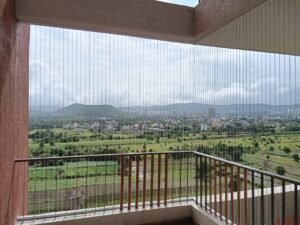
Introduction to Grilling Solutions
Grills play a pivotal role in enhancing outdoor living spaces, serving not only as essential tools for cooking but also as elements that elevate the aesthetic appeal of a home environment. The concept of grilling has evolved over the years, moving from purely functional appliances to sophisticated solutions that add value and style to outdoor areas. Different types of grills, including traditional grills and the increasingly popular invisible grills, cater to diverse tastes and practical needs.
Traditional grills are characterized by their familiar design, often featuring visible burners and a robust structure. They have been staples in backyards, allowing families and friends to gather for barbecues and outdoor cooking experiences. These grills can vary significantly in terms of materials, sizes, and designs, ensuring a wide choice for consumers. Aesthetically, traditional grills can complement various architectural styles, though their bulkiness can sometimes clash with minimalistic or modern designs.
On the other hand, invisible grills represent a novel approach to outdoor cooking appliances. These grills integrate seamlessly into the surrounding space, often designed to be unobtrusive while maintaining the functionality required for grilling. Their elegant design allows homeowners to enjoy an unobstructed view of their surroundings, effectively merging practicality with a modern aesthetic. As outdoor living continues to gain traction, the demand for sophisticated grilling solutions like invisible grills highlights a trend toward stylish yet functional outdoor spaces.
This comparison between invisible grills and traditional grills will delve into key factors such as pricing, design, and overall impact on outdoor aesthetics. Understanding these elements is crucial for homeowners looking to invest in outdoor solutions that align with their lifestyle and design preferences.
What are Invisible Grills?
Invisible grills represent an innovative solution in the realm of safety and aesthetics for residential and commercial properties. Unlike traditional grills, which can often obstruct views and disrupt the visual harmony of a space, invisible grills utilize advanced materials and design principles to provide a nearly unobtrusive barrier. Typically constructed from high-tensile stainless steel cables or nylon mesh, these grills are engineered to maintain transparency while offering an effective safeguard against falls and unwanted intrusions.
The core design of invisible grills emphasizes minimalism, allowing homeowners to enjoy unimpeded views without compromising safety. This stark contrast to traditional grills, which can be bulky and visually distracting, is a defining feature of invisible grills. They can be installed on various types of balconies, terraces, and windows, often blending seamlessly into the architectural style of the building. The sleek lines of invisible grills contribute to a modern aesthetic that appeals to many contemporary design sensibilities.
seamlessly into the architectural style of the building. The sleek lines of invisible grills contribute to a modern aesthetic that appeals to many contemporary design sensibilities.
Moreover, invisible grills provide several benefits beyond aesthetics. The materials used in their construction are resilient and weather-resistant, offering durability that can withstand exposure to the elements. Additionally, their design promotes airflow and natural light, enhancing the livability of indoor spaces. From a safety perspective, invisible grills serve as a reliable protective measure, especially in high-rise buildings where children and pets may be present. Their unobtrusive nature effectively minimizes the risk of falls while ensuring that views remain unobstructed. Overall, the adoption of invisible grills can significantly elevate both the security and visual appeal of a property.
Exploring Traditional Grills
Traditional grills have long been a staple in outdoor cooking, providing an authentic culinary experience and a variety of options for enthusiasts. There are several types of traditional grills, including charcoal, gas, and pellet models, each showcasing distinct functionalities and appeal. Charcoal grills offer a smoky flavor that many grill aficionados cherish, while gas grills provide convenience and quick heating capability. Pellet grills, combining both wood and digital technology, deliver a unique flavor profile and ease of use.
The materials used in traditional grills contribute significantly to their performance and longevity. Common materials include stainless steel, cast iron, and carbon steel. Stainless steel is favored for its resistance to rust and corrosion, ensuring durability and requiring less maintenance. Cast iron, on the other hand, is renowned for its excellent heat retention and distribution, making it ideal for searing meats. Carbon steel offers a similar cooking experience to cast iron but is typically lighter and requires more frequent upkeep to prevent rust.
Traditional grills are often deployed in various home spaces, from backyards to gardens, enhancing outdoor entertaining areas. Their design flexibility allows for customized installations, whether built-in or freestanding, making them suitable for both small patios and expansive outdoor kitchens. The established aesthetic appeal of traditional grills aligns well with various architectural styles, offering a timeless presence in outdoor settings.
In addition to their diverse applications, traditional grills provide multiple advantages that enhance the outdoor cooking experience. Their durability ensures a long lifespan, while customizability allows users to tailor grills to specific needs, resulting in a unique cooking experience. These features, combined with the rich tradition of grilling, solidify traditional grills’ status as a favored choice for many outdoor cooking enthusiasts.
Comparative Aesthetics: Invisible vs Traditional Grills
The aesthetic appeal of grills, be it invisible or traditional, plays a significant role in enhancing the overall appearance of a property. Invisible grills, as the name suggests, offer a sleek, unobtrusive design that blends effortlessly with the surrounding environment. These modern safety solutions are often made from high-tensile stainless steel cables that are virtually invisible from a distance, thereby allowing homeowners to maintain an uninterrupted view. This quality makes invisible grills particularly appealing in urban settings or high-rise buildings, where panoramic vistas are a valued characteristic.
panoramic vistas are a valued characteristic.
In contrast, traditional grills, which typically feature metal frames and horizontal or vertical bars, possess a more robust and ornamental look. While they can provide a rustic charm, their visual bulkiness may detract from the elegance of contemporary architectural designs. Traditional grills, with their various design styles, such as wrought iron or aluminum, can enhance certain home aesthetics but may not be as versatile as their invisible counterparts. Their presence can serve as a statement piece in colonial or Mediterranean-style homes, where the distinct patterns and finishes of traditional grills can complement the overall design.
Furthermore, invisible grills offer remarkable versatility in their adaptability to various design themes. They can be seamlessly integrated into modern, minimalist, and eco-friendly designs without disrupting the aesthetic flow. Meanwhile, traditional grills can provide a touch of classic elegance but may not suit contemporary homes as effectively. Ultimately, the choice between invisible grills and traditional grills depends on the architectural style of the residence and the specific aesthetic vision of the homeowner. Both options come with their unique appeal; however, the preference for one over the other may hinge on the balance between safety and visual harmony.
Price Comparison: Invisible Grills vs Traditional Grills
When evaluating the financial implications of grill options, a pertinent comparison arises between invisible grills and traditional grills. Initially, the cost of materials plays a significant role in determining the overall expense. Invisible grills are often made from high-strength stainless steel or other durable materials, resulting in a higher upfront cost compared to traditional grills, which may be constructed from less expensive materials such as wrought iron or aluminum. As a result, consumers may find themselves investing more in invisible grills for their superior construction and aesthetic appeal.
Installation costs vary significantly between grill types as well. Invisible grills require specialized installation techniques to ensure proper fitting and safety, which can contribute to a higher labor cost. On the other hand, traditional grills typically have simpler installation processes, potentially reducing the associated costs. Homeowners should factor in these installation expenses when budgeting for either option.
Maintenance is another crucial aspect of the price comparison. Traditional grills often necessitate more frequent upkeep, such as repainting or rust prevention treatments, which can add to their overall long-term expense. In contrast, invisible grills are designed to be low-maintenance due to their corrosion-resistant materials, leading to cost savings over time. Regular cleaning is typically sufficient to keep invisible grills in optimal condition, requiring less effort and financial investment from homeowners.
Longevity also influences the total cost of ownership. Invisible grills generally offer a longer lifespan compared to traditional grills, which may need to be replaced or repaired after several years due to wear and tear. This durability can translate into significant savings over time, ultimately making invisible grills a more favorable option from a financial perspective despite their initial investment. Therefore, assessing the financial aspects of each grill type can guide homeowners in selecting the most suitable option for their needs.
Safety Features: An Essential Factor
When considering grilling solutions, safety features are a crucial aspect that cannot be overlooked. Both invisible grills and traditional grills offer various safety benefits, but they achieve these in different ways. Invisible grills, typically made from stainless steel wire, create a barrier without obstructing views, promoting a sense of safety without compromising aesthetics. This design minimizes the risk of accidents while maintaining a modern appearance.
In terms of safety standards, invisible grills must adhere to regulations set forth by local governing bodies. These standards often focus on load-bearing capacities and durability to ensure that the grill can withstand environmental factors while providing adequate protection. Proper installation is pivotal, as poorly fitted invisible grills can present potential hazards. User reviews often highlight the effectiveness of invisible grills in keeping children and pets safe, further testament to their design’s integrity.
On the other hand, traditional grills, which often include metal bars or wooden structures, provide a different approach to safety. These grills can act as physical barriers, but their visual bulkiness sometimes leads to less optimal aesthetics. Traditional grills also require regular maintenance to prevent rust and wear, which are important to address for continued safety. Moreover, they can present safety risks in case of failure, such as falling over or becoming unstable, especially if installed incorrectly.
Another factor to consider is the potential for accidents when grilling food outdoors. The heat and flames produced by traditional grills necessitate vigilance to prevent burns or mishaps. In contrast, invisible grills, due to their design and materials, allow for safer grill placements, as they do not obstruct airflow or create unnecessary hazards. User experiences frequently emphasize that safety is heightened with invisible grills, leading to more enjoyable outdoor gatherings. Thus, while both grill types have their merits, the importance of safety features remains a paramount consideration in their evaluation.
Durability and Maintenance: Comparing Longevity
When evaluating the longevity and maintenance requirements of invisible grills versus traditional grills, several critical factors come into play. One of the foremost considerations is the materials used in manufacturing each type of grill. Traditional grills often utilize metals such as steel or iron, which may be prone to rust and corrosion, particularly in environments with high humidity or frequent rain. Conversely, invisible grills typically utilize high-quality stainless steel or polymer materials specifically designed to resist harsh weather conditions. This inherent weather resistance contributes significantly to the overall lifespan of invisible grills, making them a more appealing option for long-term investments.
Maintenance routines also differ significantly between these two grill types. Traditional grills often require regular maintenance to preserve their functionality and aesthetic appeal. This includes periodic cleaning to remove residues and prevent rust, as well as touch-up painting to maintain their look over time. Furthermore, the mechanical components in traditional grills, such as burners or ignition systems, may need replacement or repairs as wear and tear occur. These maintenance activities can not only be time-consuming but can also accrue additional costs, making traditional grills less attractive for those seeking low-maintenance options.
On the other hand, invisible grills present a markedly lower maintenance requirement. Their durable materials mean that they can withstand environmental stressors without significant degradation. General upkeep involves occasional cleaning to maintain visibility and aesthetics rather than extensive repairs or replacements. The resilience of invisible grills also means they can serve effectively for many years with minimal intervention, making them a sustainable option for homeowners or businesses prioritizing longevity and aesthetic integrity.
Overall, while both grill types have their unique characteristics, invisible grills tend to offer superior durability and lower maintenance demands, creating a more sustainable solution in the long run.
Customer Preferences and Trends
In recent years, the market for grills has witnessed a notable shift in consumer preferences, particularly with the emergence of invisible grills. Surveys conducted by home improvement organizations indicate a growing trend among homeowners who are leaning towards more contemporary solutions that maintain aesthetic appeal while ensuring safety. These invisible grills, which are virtually undetectable from a distance, have captured the attention of design-conscious consumers who prioritize both functionality and appearance in their home enhancements.
Demographic factors also play a significant role in shaping customer choices when it comes to grills. Younger homeowners, particularly millennials and Gen Z, tend to favor products that offer innovative designs and enhanced safety. This demographic is more inclined to invest in invisible grills as they not only provide unobstructed views but also align with the minimalist trends that dominate modern interior and exterior design. Conversely, traditional grills often attract older generations who may value time-tested products that have been regarded as reliable over the years.
Furthermore, lifestyle changes have impacted consumer decision-making processes. With urban living becoming increasingly prevalent, many individuals are opting for solutions that maximize space utilization without compromising safety. Invisible grills are particularly appealing in high-rise apartments where limited outdoor space necessitates clever design choices. Homeowners are now more likely to consider how a grill complements their living environment rather than simply focusing on its functionality.
In conclusion, the current grill market is characterized by a distinct shift toward invisible grills, driven by changing aesthetic tastes and lifestyle preferences. As safety and design become paramount, consumers are gravitating toward options that reflect their values, fostering a landscape where innovation meets functionality.
Conclusion: Making the Right Choice for Your Home
In evaluating the choice between invisible grills and traditional grills, several key points have emerged that can guide potential buyers in their decision-making process. Both options serve the primary function of enhancing safety while adding an element of design to spaces. However, their distinct features and aesthetics cater to different preferences and needs.
The primary advantage of invisible grills lies in their unobtrusive design. They provide essential protection without compromising the view, making them an ideal choice for homeowners who prioritize aesthetics. This option allows for an open and airy feel, which is particularly beneficial for properties with scenic views or limited natural light. On the other hand, traditional grills offer a classic appeal that may align better with certain architectural styles. They are typically more affordable and easier to install, providing a straightforward solution for safety concerns.
Price is another crucial factor influencing the decision. Invisible grills tend to be more expensive due to their modern materials and installation techniques. Thus, homeowners should carefully assess their budget before making a commitment. If cost is a significant consideration, traditional grills might present a more economical choice without heavily sacrificing safety and durability.
Ultimately, the decision should be based on individual priorities such as aesthetic preferences, safety requirements, and financial constraints. Prospective buyers are encouraged to weigh these factors carefully, considering what aligns best with their lifestyle and home environment. Seeking professional advice and exploring various products can further assist in making an informed and satisfying choice between invisible and traditional grills for enhanced safety and style.

